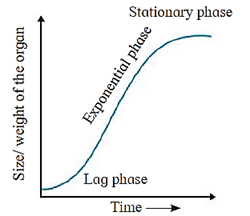Plant Growth and Mineral Nutrition
Maharashtra Board-Class-12th-Biology-Chapter-7
Solutions
Question 1. Multiple choice questions.
(1) Which of the hormones can replace vernalization?
(a) Auxin
(b) Cytokinin
(c) Gibberellins
(d) Ethylene
(c) Gibberellins
(2) The principle pathway of water translocation in angiosperms is ..........
(a) Sieve cells
(b) Sieve tube elements
(c) Xylem
(d) Xylem and phloem
(c) Xylem
(3) Abscisic acid controls ..................
(a) cell division
(b) leaf fall and dormancy
(c) shoot elongation
(d) cell elongation and wall formation
(b) leaf fall and dormancy
(4) Which is employed for artificial ripening of banana fruits?
(a) Auxin
(b) Ethylene
(c) Cytokinin
(d) Gibberellin
(b) Ethylene
(5) Which of the following is required for stimulation of flowering in the plants?
(a) Adequate oxygen
(b) Definite photoperiod
(c) Adequate water
(d) Water and minerals
(b) Definite photoperiod
(6) For short day plants, the critical period is .................
(a) light
(b) dark/night
(c) uv rays
(d) both a and c
(b) dark/night
(7) Which of the following is day neutral plant?
(a) Tomato
(b) Cotton
(c) Sunflower
(d) Soybean
(d) Soybean
(8) Essential macroelements are ............
(a) manufactured during photosynthesis
(b) produced by enzymes
(c) absorbed from soil
(d) produced by growth hormones
(c) absorbed from soil
(9) Function of Zinc is ................
(a) closing of stomata
(b) biosynthesis of 3-IAA
(c) synthesis of chlorophyll
(d) oxidation of carbohydrates
(b) biosynthesis of 3-IAA
(10) Necrosis means ...............
(a) yellow spots on the leaves
(b) death of tissue
(c) darkening of green colour in leaves
(d) wilting of leaves
(b) death of tissue
(11) Conversion of nitrates to nitrogen is called .....................
(a) ammonification
(b) nitrification
(c) nitrogen fixation
(d) denitrification
(d) denitrification
(12) How many molecules of ATP are required to fix one molecule of nitrogen?
(a) 12
(b) 20
(c) 6
(d) 16
(d) 16
Question 2. Very Short Answer Questions :
(1) Enlist the phases of growth in plants?
The three phases of growth in plants :
(2) Give the full form of IAA?
IAA = Indole Acetic Acid.
(3) What does it mean by ‘open growth’?
In plants the growth is indeterminate and takes place throughout the life at specific regions having meristems.
(4) Which is the plant stress hormone?
Abscissic acid is the plant stress hormone
(5) What is denitrification?
Anaerobic bacteria can convert nitrates of soil back into nitrogen gas. That process performed by denitrifying bacteria is denitrification.
(6) Name the bacteria responsible for conversion of nitrite to nitrate.
Nitrobacter bacteria responsible for conversion of nitrite to nitrate.
(7) What is role of gibberellin in rosette plants?
Gibberellins promotes bolting i.e. elongation of internodes just prior to flowering in plants those with rosette habit like beet, cabbage.
(8) Define vernalization.
The response of plant to the influence of low temperature on flowering in plants is called vernalization.
(9) Define photoperiodism.
The response of plant to the influence of light for initiation of flowering is known as photoperiodism.
(10) What is grand period of growth?
There are three phases of growth and the total time required for all phases to occur is called grand period of growth.
Question 3. Short Answer Questions :
(1) Write a short note on :
(a) Differentiation
(b) Redifferentiation
(2) Differentiate between Arithmetic and Geometric growth.
L, = Lo + rt where L, = length of time 't L, = Length at time zero r, = growth rate, t = time of growth W, = Wo® ™ where, W, = final size, Wo = initial size, r = growth rate, t = time of growth E = base of natural logarithm
Arithmetic growth
Geometric growth
In arithmetic growth only one daughter cell continues to divide, while the other undergoes differentiation and maturation.
In geometric growth both the daughter cells continue to divide and redivide again and again.
Rate of growth is constant.
Rate growth is initially slow but later on rapid rate.
Linear curve is obtained.
Exponential curve is obtained.
Mathematical expression is
Mathematical expression is
e.g. Elongation of root
e.g. Divisions of zygote during embryo development.
(3) Enlist the role and deficiency symptoms of : a. Nitrogen b. Phosphorus c. Potassium
(a) Nitrogen : (b) Phosphorus : (c) Potassium :
(4) What is short day plant? Give any two examples.
(5) What is vernalization? Give its significance.
A low temperature or chilling treatment that induces early flowering in plants is known as vernalization. Significance :
Question 4. Long Answer Questions :
(1) Explain sigmoid growth curve with the help of diagram.
When growth occurs in plants three distinct phases of growth are noticed.

(2) Describe the types of plants on the basis of photoperiod required, with the help of suitable examples.
Effect of light duration on flowering of plants is known as photoperiodism. Depending on photoperiodic response, plants are categorised into three types — Short day plants, long day plants and day neutral plants. (1) Short day plants : (2) Long day plants : (3) Day neutral plants :
(3) Explain biological nitrogen fixation with example.
Notes, Solutions, Text Book-PDF
PDF- Class 12th-Biology-Chapter-7-Plant Growth and Mineral Nutrition-Text Book
PDF- Class 12th-Biology-Chapter-7-Plant Growth and Mineral Nutrition- Notes
PDF- Class 12th-Biology-Chapter-7-Plant Growth and Mineral Nutrition- Solution
PDF SET :
All Chapters Notes-Class-12-Biology-(15-PDF)-Maharashtra Board-Rs-130
All Chapters Solutions-Class-12-Biology-(15-PDF)-Maharashtra Board-Rs-128
All Chapters Notes+Solutions-Class-12-Biology-(30-PDF)-Maharashtra Board-Rs-240
Main Page : – Maharashtra Board Class 12th-Biology – All chapters notes, solutions, videos, test, pdf.
Previous Chapter : Chapter-6-Plant Water Relation– Online Solutions
Next Chapter : Chapter-8-Respiration and Circulation – Online Solutions
We reply to valid query.